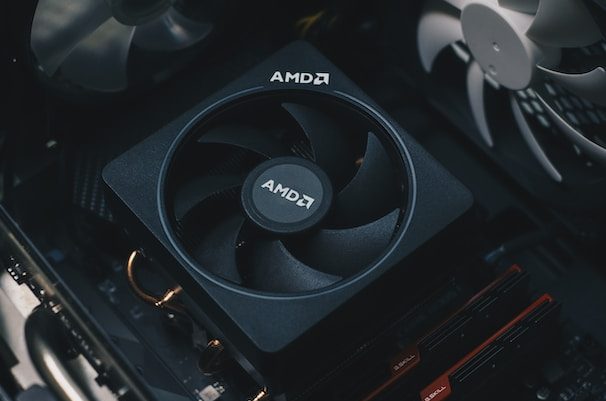Before we dive deep into the SWOT analysis, let’s get the business overview of AMD. AMD is a leading global high-performance computing, graphics, and visualization technology provider. It designs and produces microprocessors for the computer and consumer electronics industries. AMD’s operations are structured into two main business groups:
- Computing and Graphics: This group primarily includes desktop and notebook processors and chipsets, discrete and integrated graphics processing units (GPUs), data center and professional GPUs, and development services. It focuses on traditional PC devices as well as new form factors and the high-growth gaming market.
- Enterprise, Embedded, and Semi-Custom: This group primarily includes server and embedded processors, semi-custom System-on-Chip (SoC) products, development services, and technology for game consoles. AMD has a strong partnership with console manufacturers, including Microsoft and Sony, and has provided semi-custom chips for their gaming consoles.
AMD is recognized for its innovations in the semiconductor industry. They have been responsible for several industry firsts, including the first 64-bit processor, the first dual-core processor, and, more recently, the first 7nm x86 processor.
AMD is also heavily invested in research and development, continuously working on new technologies, architectures, and product designs to maintain its competitiveness in the rapidly evolving technology landscape. In recent years, the company has made notable strides in increasing its processors’ energy efficiency and bringing high-performance computing to the data center with its EPYC server processors.
Financial performance: For the full year 2022, the company reported revenue of $23.6 billion, gross margin of 45%, operating income of $1.3 billion, net income of $1.3 billion, and diluted earnings per share of $0.84.
Here is the SWOT analysis of AMD
A SWOT analysis is a strategic planning tool used to evaluate the Strengths, Weaknesses, Opportunities, and Threats of a business, project, or individual. It involves identifying the internal and external factors that can affect a venture’s success or failure and analyzing them to develop a strategic plan. In this article, we do a SWOT Analysis of AMD.
SWOT Analysis: Meaning, Importance, and Examples
Strengths
- Technology Leadership and Innovation: AMD is known for its technological advancements and has been at the forefront of many industry firsts, such as the first 64-bit and dual-core processors. AMD has recently been recognized for developing the first 7nm x86 processors. The company’s commitment to innovation is reflected in its significant annual investments in research and development.
- Strong Product Portfolio: AMD’s diverse product portfolio is another strength. Its products are suited to various applications, from desktop and laptop processors to server processors, graphics cards, and semi-custom solutions. This diversification reduces dependence on any single market segment and allows for multiple revenue streams.
- Partnerships with Major Companies: AMD has strong relationships and partnerships with other major companies in the technology sector. AMD has been the chip provider for Microsoft and Sony’s gaming consoles. These relationships provide a stable base of demand for AMD’s products.
- Increased Market Share: In recent years, AMD has gained significant market share in the CPU and GPU markets, driven by competitive product offerings. Their Ryzen CPUs and Radeon GPUs have been well-received, and their server-grade EPYC processors have also made strides in data centers, traditionally dominated by Intel.
- Skilled Leadership: Under the leadership of CEO Dr. Lisa Su, AMD has seen a considerable turnaround. She has steered the company towards strategic partnerships and innovative products, significantly improving AMD’s market position and financial performance.
- Competitive Pricing: AMD has traditionally offered its products competitively, providing a compelling value proposition for consumers and businesses looking for high-performance hardware at a lower cost.
- Focus on Energy Efficiency: AMD has made significant strides in improving the energy efficiency of its processors, which is not only beneficial from an environmental standpoint but is also an important factor for many consumers and businesses.
Weaknesses
- Dependence on Outsourced Manufacturing: AMD owns no fabrication plants and relies heavily on third-party manufacturers, primarily TSMC, to produce its chips. This dependence could expose the company to potential production delays and capacity issues, especially during times of high demand or global chip shortages.
- Intellectual Property Risks: The technology industry is fraught with intellectual property disputes, and AMD is no exception. Although AMD has a vast patent portfolio, there’s always a risk of litigation, which could lead to financial losses and distractions for the company.
- Competitive Pressure: The semiconductor industry is highly competitive. AMD faces intense competition from larger companies like Intel and NVIDIA. These competitors have more extensive financial, marketing, and distribution resources, which can put AMD at a disadvantage.
- Volatile Market Conditions: The semiconductor industry is subject to cyclical market conditions. Demand for AMD’s products can fluctuate significantly due to various factors, including overall economic conditions, consumer spending, and technological advancements.
- Limited Presence in Mobile: As of 2021, AMD has a limited presence in the mobile processor market, one of the industry’s fastest-growing segments. Unlike competitors such as Qualcomm and Apple, AMD doesn’t produce smartphone processors, which could be seen as a missed opportunity given the market’s size and growth potential.
- Dependence on a Few Key Customers: A significant portion of AMD’s revenues comes from a few key customers, like Sony and Microsoft, for their game consoles. This revenue concentration could pose risks if these key customers switch suppliers or demand decreases.
Opportunities
- Data Centers and Cloud Computing: As data consumption and the demand for cloud services grow, there is a significant opportunity for AMD’s EPYC server processors in data centers. With their high performance and competitive pricing, they could gain more market share in this space.
- Artificial Intelligence and Machine Learning: AI and ML are rapidly growing fields requiring substantial processing power, providing an opportunity for AMD’s high-performance CPUs and GPUs. AMD can invest more in developing products specifically designed for these applications.
- Gaming and VR/AR Market: The gaming market, including consoles and PC gaming, continues to grow, and the emergence of virtual reality (VR) and augmented reality (AR) technologies offer new opportunities for AMD’s graphics processing units (GPUs).
- Continued Demand for Remote Work Solutions: The shift to remote work due to the COVID-19 pandemic has increased the demand for personal computers and laptops. If this trend continues, it could provide a sustained boost to AMD’s sales.
- Partnerships and Collaborations: AMD can look to forge new partnerships and collaborations in the tech industry to increase its market presence and diversify its revenue streams. For instance, partnerships with companies in the automotive or Internet of Things (IoT) sectors could be beneficial.
- Expanding in Mobile Processor Market: The mobile device market, particularly smartphones, and tablets, is a sector where AMD has potential for growth. It’s an area where their main competitor, Intel, has also struggled, so there could be room for a new player to establish a foothold.
- Emerging Markets: As technology adoption continues to rise in emerging markets, AMD can increase its global market share. These markets could provide significant growth opportunities for all AMD’s product lines.
Threats
- Intense Competition: The semiconductor industry is extremely competitive. AMD’s primary competitors, Intel and Nvidia, have significant resources and continue to innovate in their product offerings. Any competitive missteps by AMD could lead to a loss of market share.
- Supply Chain Disruptions: AMD relies heavily on external manufacturers, mainly Taiwan Semiconductor Manufacturing Company (TSMC), for its chip production. Any disruption in these relationships or external factors affecting these manufacturers could impact AMD’s ability to meet customer demand.
- Technological Disruptions: The technology industry constantly evolves, with new technologies potentially making existing ones obsolete. It could hurt its competitive positioning if AMD fails to keep pace with these rapid changes.
- Economic Conditions: Like any business, AMD is susceptible to global and regional economic fluctuations. Reduced spending on technology products during economic downturns could impact AMD’s revenues.
- Regulatory Changes: Trade policy or regulation changes can impact AMD’s operations, particularly as it operates globally and relies heavily on manufacturers in Asia. For instance, increased tariffs or trade restrictions could raise AMD’s costs.
- Dependence on Key Customers: AMD derives a significant portion of its revenue from several key customers, including Sony and Microsoft. Any changes in these relationships, such as these companies deciding to switch to a different supplier, could significantly impact AMD’s revenues.
- Cybersecurity Threats: As a tech company, AMD is at risk of cyber threats that could lead to the theft of intellectual property or sensitive information, which could negatively impact the business.









